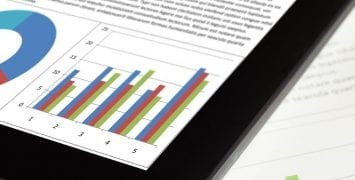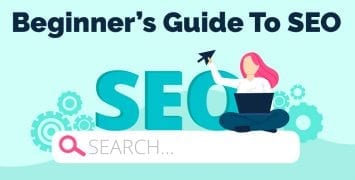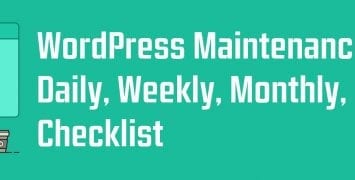Your 54-Point Guide to Having a Perfectly Optimized Website
Here at The Guerrilla Agency, we’re aware of how challenging industry-specific SEO can be. Many important factors play into optimizing your company’s website, from overall performance and device versatility to markup strategy and linkage. Industry focus aside, the following points each play crucial roles in your website’s SEO success.

Speed + Performance
When potential or existing clients visit your website, they expect a positive user experience through impressive speed and performance. Analyzing your website’s speed and performance will help drive more traffic and encourage clients to continue returning. Many factors impact the speed and performance of your website:
- Clean Code: When visiting a website, you expect it to load quickly, so you can review the information you’re seeking. More times than not, if a page doesn’t load within three seconds, your potential buyer will move onto the next best thing. Clean and efficient code makes a substantial difference in how quickly a page loads. Reviewing your HTML documents to ensure CSS and JavaScript are in the right place is a necessity, along with reducing CSS file size.
- Valid Code: Many different code types can be used for web design, but you must use the right code for optimal speed and performance. Utilizing HTML code is valuable for site updates and makes it easier for web crawlers to crawl, resulting in better-understood website content.
- Server: Websites work differently with each server, and this factor is commonly brushed aside during a launch. It’s encouraged to test different servers to see what works best for your website, as some will cause slow load time and unnecessary interruptions.
- Page Size: Shortening your website copy into digestible, easy-to-read pieces doesn’t only help viewers – it also increases speed and performance. Longer web pages with an abundance of images or other loadable content can cause navigation issues and might not always load how you had hoped.

Device Versatility
The days of only desktop computers have been over for quite some time. Today, the consumer market can visit your website from mobile devices, laptops, and even tablets. When designing your website, it’s encouraged to test your page on multiple devices, so you can be sure it loads correctly, and you’re drawing the traffic you’ve been aiming for.
- Responsive: Creating a responsive web design optimized for device use other than a desktop or laptop makes your website accessible for viewers to locate your online content from various mobile devices.
- Mobile Site: Each device available on the market today displays websites differently, making it extremely important to optimize your content to allow for the best mobile experience possible. Designers can complete this by tweaking footers, menus, font, sections, and other noteworthy website features.

Heightened Security
Your website’s security is a detail that must be paid attention to as it affects current and future success. As with any service or product, malware and hackers continue to transform and optimize their tactics when accessing data and personal information. Implementing practical preventative measures and continuously being aware are both excellent ways to maximize website security.
- Anti-Hacking: There are many different anti-hacking measures you can implement on your website to ensure optimal functioning. It’s encouraged to explore two-step verification, site backups, and anti-virus software as each of these elements helps preserve your website and prevents the likelihood of hackers.
- HTTPS: You are likely already familiar with HTTP, and HyperText Transfer Protocol Secure (HTTPS) is an enhanced security version of HTTP. Incorporating this into your website will optimize security while improving Google rankings.
- Content/Link Injections: At times, hackers can insert malicious code onto your website, referred to as link injection. Hacking and SEO terrorism can happen when we least expect it, making it incredibly important to look out for link injections and address them immediately.

Is My Website Crawlable?
Your website’s crawlability is a vital component to your website’s success, online visibility, and a search engine’s ability to categorize your website as relatable content to a searcher’s intent. Crawlability is a term used to explain how a search engine’s crawlers visit a website and save the HTML in a database called an index. The index is continuously updated as websites and pages are changed and are what search engines utilize to provide users with search results.
- Indexation Analysis: Conducting an indexation analysis not only allows you to observe what content potential clients see after a search but enables you to get a better understanding of any pages that may be wasting time when crawled by a search engine.
- Sitemap: A sitemap provides a general overview of all pages within your website. This organized resource allows for simple navigation and provides clarity for search engines to further understand page content and organization during a website crawl.
- Robots.txt: The movement of crawlers can be controlled by using a robots.txt file. This file provides directions for crawlers, such as what pages should and shouldn’t be crawled within your website.
- Log File Analysis: Each request made to your website’s server is documented in a log file. Accessing your log file and analyzing the resources search engines are crawling will help you improve SEO exponentially through adjusting poor crawl spend and addressing page errors.
- Crawl Budget: Through a crawl budget, you can discover the number of times a website page is crawled and how often a deep crawl is completed. Your crawl budget can be optimized with these findings, resulting in crawlers quickly discovering the best content on your website for viewers.
- Crawl Depth: Like a crawl budget, you can also analyze crawl depth, which is the duration your website pages are crawled and indexed. This information lets you see what pages, main or sub, are crawled and for what time length.
- Crawl Rate: Analyzing the pages’ crawl rate on your website will help you judge if any changes need to be made. Certain content takes longer for bots to crawl, and a low crawl rate can affect overall traffic and page indexing.
- Errors (404s): It’s essential that you limit the likelihood of “Page Not Found” or 404 errors as soon as possible. If not addressed right away, 404 errors can have an enormous impact on your website’s performance, meaning any internal and external broken links should be discovered and fixed immediately.
- Server Redirects: 301 and 302 server redirects also help optimize your website’s SEO strategy. Incorporating server redirects will help redirect site visitors to a varying URL if the first URL has been moved temporarily or permanently.

Redesigning + Making a Move
Depending on the change you’re choosing to implement on your website, a website migration can range in the number of tasks and simplicity. Website redesigns and platform changes are both examples of website migration and usually have the end goal of increasing traffic rather than decreasing.
- HTTPS: An easy way to improve your search rankings is to migrate your website from HTTP to HTTPS. Not only will this increase protection for your website, but it will likely draw more traffic in the long run.
- Redesign: Completing a website redesign can negatively impact your website’s performance and SEO strategy if done incorrectly. However, if done correctly, the benefits are endless. If you choose to conduct a website redesign, give special attention to 301s and 404s, finetune your sitemap strategy, and conduct thorough testing.
- Moving Platforms: At times, you may find that a different platform is more beneficial for your website and overall performance. To move your website to another platform successfully, you must have a detailed strategy and be prepared to conduct thorough testing both pre- and post-move.

How Can Search Engines Better Understand My Content?
Strategies called markup are utilized to structure content that appears on your website, so search engines can better understand the content and provide users with relevant results more efficiently.
- Schema Tags: A schema markup is utilized to help search engines provide more informative, relevant results. Schema tags are used to optimize the rich snippets of content. Schema tags and markups can both help improve how your website looks in SERPs.
- Open Graph: Many may know open graph as open graph protocol. This markup allows a website to become its own rich snippet in graph form. Open Graph protocol helps move website content to position zero in Google SERPs.

What About Behind the Scenes?
Your website’s overall usability can be improved by giving special attention to the internal architecture such as pagination, URL structure and parameters, and optimized content. Each of these details will help create a better user experience.
- Pagination: At times, blocks of website links are connected, which makes it easier to find. This is called pagination and can be identified as navigation sections wrapped as.
- Topical Focus/Dilution: A majority of the content on your website is topic focused, and dilution adds authority to a site. Optimizing your content to cover your industry and niche will help categorize your website as a subject matter expert, meaning traffic will likely increase as a result.
- Sub-Topical Organization: While topical focus helps build credibility as a subject matter expert, sub-topical organization will also add authority to the various topics covered on your website.
- URL Structure: Becoming familiar with popular subject keywords and incorporating them into your URLs will improve your website’s rankings. Search engines and users are more likely to find your website during a search if there is a relation between page subject, page content, and URL structure.
- URL Parameters: You can incorporate URL parameters into your website’s URLs to track information about a user click. While this isn’t necessary for all content, you can generally identify URL parameters in influencer marketing or promotional URLs.
- Click Depth: Reviewing your website’s click depth is a great way to improve your website’s internal architecture. Click depth is a term used for how many clicks a website visitor must execute to go from your home page to another page within your website. A lower click depth is the ultimate goal as this allows for the optimal user experience and will provide you with positive results.

Different Kinds of Links
While it may seem minuscule, the types and quality of links you incorporate into your website content matters to its overall success. When optimizing your website’s SEO, it’s vital that you give attention to internal, outbound, and broken links as each impact your website’s performance and credibility.
- Internal: Within your website, links used in anchor text and call to action (CTA) buttons are categorized as internal links. Internal links are incorporated into your website to redirect users to another web page to prolong their stay.
- Outbound: Like internal links, outbound links are used in anchor text and affiliate ads throughout your website to redirect users to other websites. Outbound links are incorporated to draw more traffic to your website from outside sources.
- Broken: Internal and outbound links lead to another webpage within your website or other websites all together. Broken links occur when an outside website is deleted, or an internal page has been changed without utilizing a 301 redirect. If broken links are on your website, the user won’t be led anywhere upon clicking.

The Ins and Outs of Content
Optimizing your website content is the key to increasing your website’s online visibility, traffic, and search engine ranking. Incorporating quality content into your website doesn’t only affect the previously mentioned, but provides users with easy-to-read, trustworthy content.
- Quality: Incorporating quality, credible content into your website is the key to keeping visitors engaged, and proving authority within your industry and niche. Not only does quality content fulfill a searcher’s intent, but it will also drive traffic and improve your rankings.
- Readability: Your website will rank highly and have increased traffic if you give attention to your content’s readability. Users and search engines must understand the content, meaning clear and clean content is a priority.
- Duplication: Try to avoid content duplication as best you can as this can affect the ranking of your website, and not always in a good way. Similar products should have varying descriptions, and product descriptions from the manufacturer directly should be avoided. Along with these two details, Meta description content and SEO titles should be analyzed for duplication and fixed accordingly.
- Meta: Search engines utilize Meta descriptions and Meta title tags to determine what your website is about. Searchers also read Meta descriptions and titles when reviewing SERPs, meaning catchy, optimized content is vital to draw potential customers’ attention.
- Canonicalization: Canonical tags are in place to tell search engines that a webpage is the master key. Incorporating canonical tags prevents the likelihood of duplicate content or URL issues, which, if not addressed, can hinder the performance of your website.
- Keyword Categorizations: At times, it’s beneficial to group keywords together under a larger or more popular keyword. The technique of keyword categorization allows you to increase your monthly search volume by using a larger number of easier ranking keywords to improve the likelihood of ranking for a more difficult keyword.

What About Visual Components?
Along with written content, the use of visual content such as videos or images is also essential. Adding high-quality visuals to your website will help break up written content and enhance the user experience.- Image Optimization: The written content on your website isn’t the only material that needs optimization. Incorporating high-quality images into your website will help minimize the page load time, especially on websites that require an abundance of visual content.
- Video Optimization: Video content can harm your website if the material isn’t optimized correctly. It’s encouraged to embed a YouTube video code rather than attempting to upload video files. If YouTube video codes aren’t utilized, your site’s speed will likely decrease substantially.
- Others (PDF, DOC, PPT): Multimedia files added to your website can slow the time in which a page loads, thus affecting the user experience. Regardless of the type of multimedia file you’re adding to your website; it’s essential to ensure the materials are optimized.

It’s All About Building Trust
The foundation of a successful website is formed out of trust. Upon visiting your website, users expect to trust the content and believe it is being delivered from a trustworthy, credible source. Many elements can be incorporated into your website to help build trust.
- Credentials: When visiting your website, potential customers will appreciate having access to review any credentials or awards. Displaying this material will not only build trust but show that your content is credible and genuine.
- Contact Details: If a potential customer is interested in your products or services, they’ll likely begin searching for contact information, should they have any questions or concerns. Displaying contact details verifies that you are real and can be contacted easily.
- Testimonials: Incorporating testimonials into your website provides potential customers with examples of how your products or services have helped previous customers. This will help you gain appreciation within your industry and show new customers the impact your products or services have already had.
- Privacy: Cybersecurity has always been a concern as the popularity of hackers and security breaches has continued to grow. Adding a privacy policy to your website will show potential customers that you’re invested in their information safety and display the protocol used to keep it safe and inaccessible to outside individuals.
- Terms & Conditions: Including terms and conditions on your website will enhance trust and is information the standard user expects to see.
- Author Authority: Giving special attention to author authority is essential as it provides users with the knowledge that a credible individual is providing the information.
- Social Signals: Reviewing your social following and engagement is a large factor that can positively impact your website’s success. Social media and your website work hand in hand, meaning potential customers are more likely to visit and trust your website if you have made a noticeable impact on social media platforms, whether through digital marketing and other strategies.

Get Down to Business
By reviewing the business intelligence aspects of your website, such as conversion rates, length of buying cycle, and lifetime value, you’ll have the tools to successfully finetune your SEO performance and learn more about your client base.
- Conversion Rate: Each website has a conversion rate determined by the percentage of site visitors that complete a displayed task. This can be anything from a product or service sale to signing up for a newsletter or completing an inquiry form.
- Length of Buying Cycle: Reviewing and optimizing your length of buying cycle can further help optimize your website’s performance. A shorter length of buying cycle will help increase traffic and turn potential customers into customers in no time.
- Lifetime Value: Along with conversion rates and the length of buying cycle, it’s also essential that you review your customers’ lifetime value. Within lifetime value, you can check how many purchases a customer makes over their lifetime or how often they visit your website to read blogs and other content.

Creating a Positive User Experience
Your clients expect a user-friendly experience that is low stress and enjoyable. Upon visiting any website, you hope to run into minimal issues and find information easily. Keeping this in mind and creating a website that caters to the user experience will help increase the satisfaction and engagement of your users.
- Bounce Rate: A low bounce rate is a good sign when reviewing the analytics of your website. This term refers to the percentage of users that land on a webpage but take no further action or interaction with your website. A low bounce rate shows you that users find your content credible, informative, and your website is easily navigated.
- Time On Site: Reviewing the duration of each user’s visit is essential, as this displays the likelihood of engagement. If you’re noticing shorter times for on-site durations, it may be a sign that you need to optimize content further to enhance the user experience.
- Pogo-Sticking: At times, a user will search for a product or service and bounce between various websites until finding the content

Successfully Navigate Your Next SEO Audit
While this may seem like a lot of information to sift through, the previously mentioned points are all areas that you should check during your next SEO audit to ensure your website is set up for success. Conducting regular, in-depth SEO audits will not only ensure users are given the ultimate experience but will verify that your website is functioning optimally and is drawing all necessary traffic. Our industry-leading SEO experts are ready to guide you through your next SEO audit, so you can begin getting the results you’ve been hoping for.




